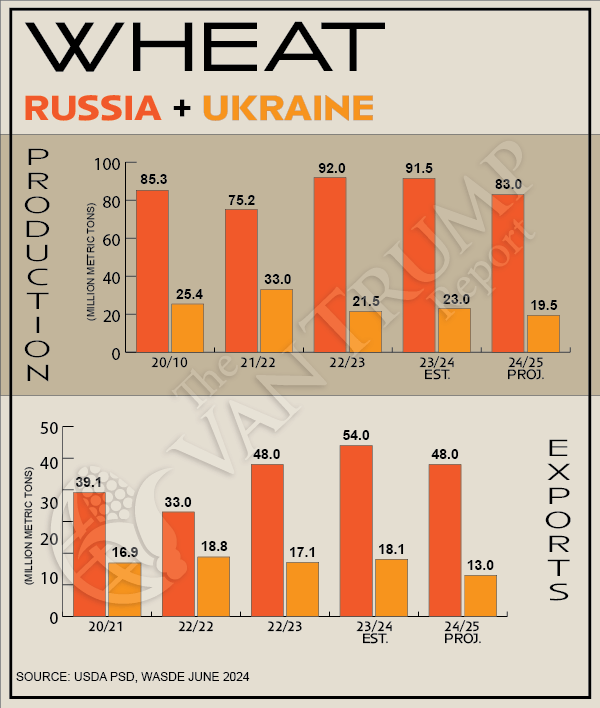Russia has declared a series of federal emergencies recently amid crop-damaging frosts and drought that are denting the country’s wheat prospects. The US Department of Agriculture (USDA) in its most recent June update trimmed Russia’s 2024-25 wheat production by -5 million metric tons (MMT) to 83 MMT. Other forecasters are even less optimistic, including local analyst Sovecon that pegs the crop at just over 80 MMT.
According to reports from Sovecon, from mid-March to mid-April, moisture levels in southern Russia were 60% to 80% of normal along with above average temperatures. Meanwhile, in early May, central and southern Russian crop growing areas suffered from severe frosts. Russia on June 7 declared a state of emergency in 10 regions because of damage to crops from the May frosts. Less than a week later, it declared a state of emergency in the southern Rostov region due to drought.
There is significant disagreement as to how much damage these weather events have done. Russia’s Ag Ministry estimates total crop losses from May frosts at around 2.5 million acres, or 1.2% of the total sown area for the 2024 harvest. The ministry says another 1.73 million or so acres suffered some degree of damage.
However, Arkady Zlochevsky, head of Russia’s grain union, says the ministry’s -1.2% loss estimate from frost was referring to all crops, including grasses and fodder. He estimates the damage to winter grains specifically is much higher, “from 15% to 20-25% and even 30% – (depending) on the region,” though he gave no estimate for wheat alone.
Russian officials have not provided an estimate of any potential losses caused by drought but sources have estimated the losses as high as -30%. The ag ministry did note that it may later adjust its 2024 grain harvest forecast, including 86 million tons of wheat, due to the dry conditions.
As for exports, Deputy Prime Minister Dmitry Patrushev said on May 31 that grain exports would fall to 60 MMT in the 2024/25 season, which starts on July 1, down from 70 MMT in the current 2023/24 season, due to a smaller than expected crop after a cold spell in some regions. Russia has not provided a stand-alone estimate for wheat exports but officials recently said exports will not be impacted by the production setbacks and are so far maintaining their current forecast. USDA lowered its 2024/25 Russian wheat export projection to 48 MMT from 52 MMT previously and down from an estimated 54 MMT in 23/24.
Russia is the world’s largest exporter of wheat – one in every four wheat shipments on the global market originates from the Eastern block. One of its biggest customers is Turkey. According to the USDA, Turkey was the fourth-largest global wheat importer in 2024-25 with 10.5 MMT. You may recall that Turkey just recently banned wheat imports starting June 21 through October 15 in an effort to protect local farmers. Meaning more Russian supplies could be freed up for the global market.
At the same time, India is expected to make rare wheat imports this year. Traders estimate that importers could bring in anywhere from 2 to 5 MMT, likely of Russian origin. That would in turn offset some of Turkey’s lost demand.
It’s worth noting a warning from Andrey Sizov of the Sovecon that the rapidly deteriorating prospects for Russia’s wheat crop, combined with rising domestic prices, means the risk of Russia placing additional restrictions on grain exports have increased.
It’s also worth noting that the dry weather in southern Russia extends into Ukraine. USDA just lowered its forecast for Ukraine’s wheat crop to 19.5 MMT from 21 MMT previously and down from 23 MMT last year. Ukraine’s wheat exports likewise were trimmed to 13 MMT from 14 MMT in May.
Keep in mind, it’s increasingly difficult to know what’s really going on inside Russia. Western ag companies are no longer operating in the country and most of the industry has now been taken over by the state or Russia-controlled entities. Russia has also stopped publishing its customs data in 2022 so USDA and other agencies rely on other sources to compile their data. (Sources: USDA, Reuters, Sovecon)







